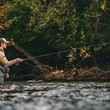On a guided float in Wyoming some time ago — and I think it’s a great idea for every angler, regardless of skill level or angling proficiency, to take a guided trip now and then — I got a great tip that has paid dividends ever since, no matter where I’ve stripped flies or what fish I’ve chased.
After the third hit-and-run on my streamer from a big Salt River brown, I was frustrated. The fish were into my fly pattern, but I just couldn’t hook up.
“Why do they always hit the fly when I’m between strips?” I asked, somewhat rhetorically and, frankly, hoping the guide would deliver the answer to my question. I was legitimately troubled — I love to strip streamers, but there are days when the “discipline within the discipline” can be maddenly frustrating.
When fish, particularly trout, grab flies between strips, it also means that, for most anglers, they’re hitting flies when the stripping hand is off the line, and the only connection that remains between the fish and the angler are the fingers of the right hand as they pinch the line against the butt section of the rod (for argument’s sake, the angler is right-handed—obviously, the opposite is true for southpaws). There’s just not enough tension between the angler and the streamer (and the fish!), and it makes a strip-set impossible.
I turned and looked at the guide who answered my prayer to the angling gods.
“Don’t take your stripping hand off the line so much,” he said. “Instead of letting go with your left hand after every strip, do a strip-and-pause move, and do it three times in a row, all while keeping your left hand on the line.”
It might sound complicated, and it sure felt awkward, but it proved effective. Instead of pinching the line against the fly rod with my right forefinger and middle finger while reaching up to grab the fly line to re-strip the streamer after every pull, I simply kept my left hand on the line and performed the “strip and pause.” I pulled once, paused. Then a second time. Another pause. And finally a third. Only then would I reach up and grab the fly line for a repeat performance.
Yes, I still had to release the line with my left hand, but only once after three strips instead of after every strip. This allowed me to keep in contact with the line (and the streamer) more often. It also made for a more efficient strip. And, when a nice big brown nailed the sculpin pattern after the second pause, the line was in my hand and the strip-strike was solid. The payoff? A stunning 19-inch brown trout in the net.
The guide earned his tip that afternoon.
And since that day, the “strip-and-pause” method has worked on a number of occasions. In the Bahamas, I used the method while casting over a school of mudding bonefish. In Patagonia, I’ve used the method for giant lake-dwelling brown trout. And in Mexico, the method was money on baby tarpon in the backcountry sloughs of Ascension Bay.
Strip. Pause. Strip again. Don’t let go of the line with the stripping hand but once every three or even four strips.
Oh, and back to what I said about taking a guided trip: The craft evolves, even if we’re not paying attention. Longtime anglers should consider a guided trip like taking a training class for some new software they need to master for the day job. Or an updated safety test to make sure they’re at their best when they need it the most.
It never hurts to go back to school. For this angler, who’s been on the business end of a fly rod for some four decades, the education never really stops. That was proven to me by a great guide who knew the river, knew the fish and, more importantly, was willing to share a new trick with an old dog.
The end result? I’m a better angler. And you can be, too, if you just have the humility to take a refresher course now and then.






























Comments